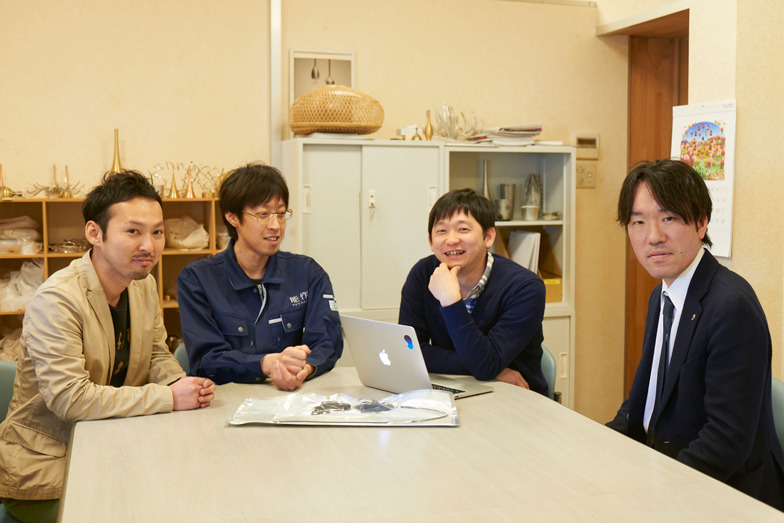Traditional craft industries, the origin of Japanese manufacturing and symbols of regional culture, have long contributed to economic development. Recently, however, they face many challenges, including sluggish demand due to changing lifestyles and a shortage of successors among producers.
Amidst this, the "Good JAPAN Innovation" project was launched. It brings together exceptional Japanese craftsmanship and Dentsu Inc. art directors under the theme "Traditional Crafts × Design" to create collaborative works and communicate new value to the world.
The first installment involves the redesign of products utilizing Toyama Prefecture's casting techniques.

Work Title:
PELAMP (Photography: Shota Endo, Floral Arrangement: Tenshin Nakano)
An LED desk lamp with a tin body
The history of casting in Takaoka City, Toyama Prefecture, began in 1611 when Maeda Toshinaga, lord of the Kaga domain, invited seven casting artisans. This casting technique, continued for over 400 years, has supported the Buddhist altarware manufacturing industry to the present day. This redesign is a product utilizing Toyama's casting techniques: the 'PELAMP' LED desk lamp with a tin body. Tin has the characteristic of bending easily; its shape can be altered by pulling or gripping it. Embracing this malleability as a function, it was finished as a single, straight sheet of thin tin. It can be freely bent and reshaped countless times.

This product was realized through a collaboration between Toyama Prefecture's foundry manufacturer "Nosaku" and furniture/interior retailer "Yonesan," driven by a desire to revitalize the region's traditional industries. Dentsu Inc. Kansai's Art Director Tanaka interviewed Mr. Isoiwa and Mr. Umeda from Nosaku, and Mr. Masuyama from Yonesan about this product development.

From left: Nosaku's Mr. Isoiwa and Mr. Umeda, Dentsu Inc. Kansai CRP Bureau Tanaka, Yonesan's Mr. Masuyama
Design City Toyama already had a foundation for design thinking
Tanaka: Regarding the creation of this product, Nosaku, the long-established tinware company providing the technical expertise, received a sudden request from designers asking, "Can you make this kind of lighting?" Was there any hesitation or reluctance?
Isoiwa: Nosaku has been around for 100 years, but our current president comes from a different industry, so he's open to new things. That's why we never turn down work. PELAMP looks simple, but creating straight lines is actually quite difficult. However, we believe taking on challenges is necessary to keep pace with the times.

Tanaka: As a designer, that's an incredibly welcome stance. I love seeing the moment when craftsmen overcome high hurdles with their ingenuity and resourcefulness. Mr. Masuyama from Yonesan has been involved since the project's inception. Did he immediately agree to participate in this project?
Masuyama: Yonesan has a 167-year history. Originally a food merchant handling rice and oil, then a wholesaler and retailer of lacquerware, and later a furniture retailer—our business model has changed roughly every 50 years. We felt now was the time to shift away from mass retail. I also resonated with the desire to contribute to Toyama Prefecture's manufacturing and the initiative to collaborate with local traditional industries, where designers engage in hands-on craftsmanship.
Tanaka: Both companies are facing the changes of the times head-on!
Umeda: At Nosaku, the average employee age is now 35. The president even says he considers the current members to be the founding members.
Tanaka: Though it's called a traditional craft industry, they're using that skill to explore new frontiers in manufacturing with younger members.
Masuyama: There was a time when interior items sold in large quantities around weddings or moves, but now they're not necessities—they're luxury items. Yonesan aims to become a presence that elevates people's lives through interior curation.
Tanaka: Curating interior items is a great concept. Recently, Toyama has been called a design city, but what was its original connection to design?
Masuyama: Since ancient times, Toyama has thrived in traditional industries like casting, bronzeware, lacquerware, sculpture, and washi paper. It's also a prefecture where woodblock printing flourished, seen in things like the packaging for "Toyama's Medicines." So, I think the foundation for graphic design and product design thinking has always been here.
Tanaka: I see! I thought you were revitalizing the town through design, but it turns out the prefecture already had deep-rooted design thinking! From now on, I might just end up choosing only "made in TOYAMA" items (laughs). I want to keep promoting Toyama's craftsmanship, so please count on me! What should we create next?

Getting fully immersed in regional traditional industries like this reveals so many things I never knew before. This "PELAMP" product was born precisely because we were blessed with members like them, who have such a strong passion for making things. Learning about Toyama Prefecture's manufacturing stories has made me love Toyama even more!
You can purchase "PELAMP" here.
PELAMP Making Movie












